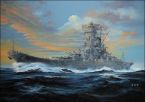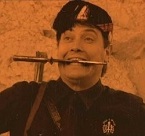kfsgo
Posts: 446
Joined: 9/16/2010
Status: offline

|
quote:
ORIGINAL: GreyJoy
Unfortunately we have strict HRs that limits night bombing to 10k feet and to 50 max bombers during the full moon nights.... Not a viable option...
You have to kind of admire Rader's brazenness in setting up this stuff, in a way.
quote:
For the third mission, LeMay had designated Osaka, not as yet hit by a major air strike. Osaka, situated on Osaka Bay, the eastern limit of the Inland Sea, was Japan's second city in size and in industrial production. Its harbor facilities and excellent rail and highway connections made Osaka an important transportation center. It produced about one-tenth of Japan's wartime total of ships, one-seventh of her electrical equipment, one-third of her machinery and machine tools. The Osaka army arsenal furnished 20 per cent of the army's ordnance requirements. No airplanes were assembled at Osaka, but nearly a fourth of its half-million workers were engaged in the manufacture of parts and components for aircraft and engines. Osaka was also a great commercial city and an important administrative center. Because of conscription and the mushrooming of war industrial plants in the suburbs, the population of the city proper had shrunk from 3,254,380 in 1940 to an estimated 2,142,480 in February 1945. This shift had reduced the density of population (to 81,000 per square mile for the central commercial section and adjacent residential-industrial districts) without greatly affecting the built-upness. The scene of many earlier disasters, Osaka had cut a number of firebreaks through congested areas to add to the protection given by its numerous canals and had built many modern fire-resistive buildings, but its crowded districts of highly inflammable houses offered an ideal incendiary target.
The Osaka strike was scheduled before final results of the Nagoya mission had been evaluated. Reports from observers were sufficient, however, to raise doubts as to the correctness of the tactics followed, and operational planners tried to reproduce the pattern which had worked so well at Tokyo. The intervalometer setting was changed back to fifty feet and crews were warned to achieve a higher concentration in the target area. No specific method was prescribed although crews were briefed to check position carefully before releasing the bombs.
Thanks to heroic efforts on the part of maintenance crews, the command was able to put up 301 B-29's in a late afternoon take-off on 13 March. The planes carried the same 6-ton bomb load, but the low wing was given .50-caliber ammunition for lower forward and aft turrets as well as for the tail guns. When the force of 274 planes that got over Osaka found an 8/10 cloud cover, it had to resort to radar bombing. This proved an advantage rather than a handicap. Unable to sow their bombs by sighting visually on pathfinder fires, bombardiers were forced to drop after a controlled run, releasing on an offset aiming point. With this technique, the B-29's achieved a thicker and more uniform pattern than had been possible with the impressionistic methods used at Nagoya.
The results showed conclusively that the Tokyo raid had not been a fluke. The 1,732.6 tons dropped on Osaka in about three hours wiped out 8.1 square miles in the heart of the city. The chief commercial district was ruined, and fires were kindled in the industrial sections where 119 major factories were destroyed, including some engaged in heavy industry. As the flames spread rapidly, fire-fighting and air-raid protection (ARP) services were completely demoralized. Casualties mounted as persons were suffocated in makeshift shelters or were burned trying to run through the flames. The records of the Osaka fire department listed 3,988 dead, 678 missing, 8,463 injured.
Note that the B-29B, which will make up half your total B-29 allotment from March 45, is explicitly a night bomber - all the defensive armament except the tail gun is removed.
< Message edited by kfsgo -- 1/23/2012 9:36:16 AM >
|
 Printable Version
Printable Version








 ...yesterday night my GF (Valentina) decided it was wise to spend the night by my appartment...so we went out with friends and when we came back i had the turn to play...i placed her on the sofa and asked her (politely) to stay quiet, to watch tv, and to leave me alone for an hour... it lasted less than 20 min...that she started to complain (That game is more important to you than me...you are obsessed by that game...who gives a **** about a canadian engineer who lives on the other side of the globe etc etc etc...bla bla blah....)...so i had to rush the orders and probably i messed up a bit...
...yesterday night my GF (Valentina) decided it was wise to spend the night by my appartment...so we went out with friends and when we came back i had the turn to play...i placed her on the sofa and asked her (politely) to stay quiet, to watch tv, and to leave me alone for an hour... it lasted less than 20 min...that she started to complain (That game is more important to you than me...you are obsessed by that game...who gives a **** about a canadian engineer who lives on the other side of the globe etc etc etc...bla bla blah....)...so i had to rush the orders and probably i messed up a bit...

 You're a lucky man!
You're a lucky man!







 ...so we probably need to re-think our HR about night bombing....let's see what Rader thinks about it. I trust his judgement
...so we probably need to re-think our HR about night bombing....let's see what Rader thinks about it. I trust his judgement


 New Messages
New Messages No New Messages
No New Messages Hot Topic w/ New Messages
Hot Topic w/ New Messages Hot Topic w/o New Messages
Hot Topic w/o New Messages Locked w/ New Messages
Locked w/ New Messages Locked w/o New Messages
Locked w/o New Messages Post New Thread
Post New Thread